Tempest over Texas: The crash of Braniff International Airways flight 352
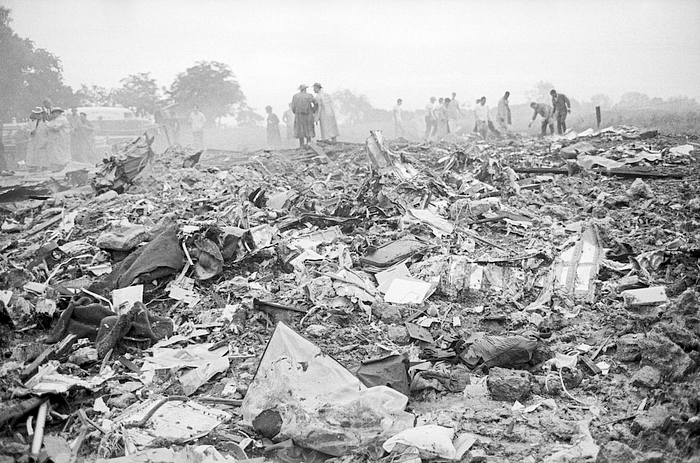
On the 3rd of May 1968, a Lockheed L-188 Electra on its way from Houston to Dallas encountered a line of powerful thunderstorms high above the plains of Texas. But as air traffic controllers busily rerouted aircraft around the east end of the squall line, the crew of the Electra announced their intention to buck the trend: there were gaps to the west, they insisted, and that was where they would go. Unfortunately, their choice swiftly proved itself unwise, as they and their passengers plowed headlong into a monstrous, black storm, surrounded by lightning, rain, and violent winds that threatened to rattle the plane apart. Realizing too late that he had made a mistake, the captain attempted to turn back the way he had come — but as he began a steep, 180-degree turn amid severe turbulence and wild gusts, he lost control of the plane, slipping into a terrifying downward spiral from which they would never emerge. Seconds later, as the crew tried desperately to recover from the high-speed dive, the big four-engine turboprop lost a wing and plunged burning to the ground, taking with it the lives of all 85 passengers and crew.
The story of their final minutes was one of tragic hubris, poor decision-making, and insufficient respect for the wrath of mother nature. In fact, when compared with official guidance today, the tale of Braniff flight 352 is a veritable checklist of what not to do when flying near thunderstorms, providing useful lessons for those who still face the same dilemmas more than half a century later. What follows is a reminder of how those modern rules of thumb for dealing with thunderstorms came about — and why adherence is a deadly serious matter.
◊◊◊
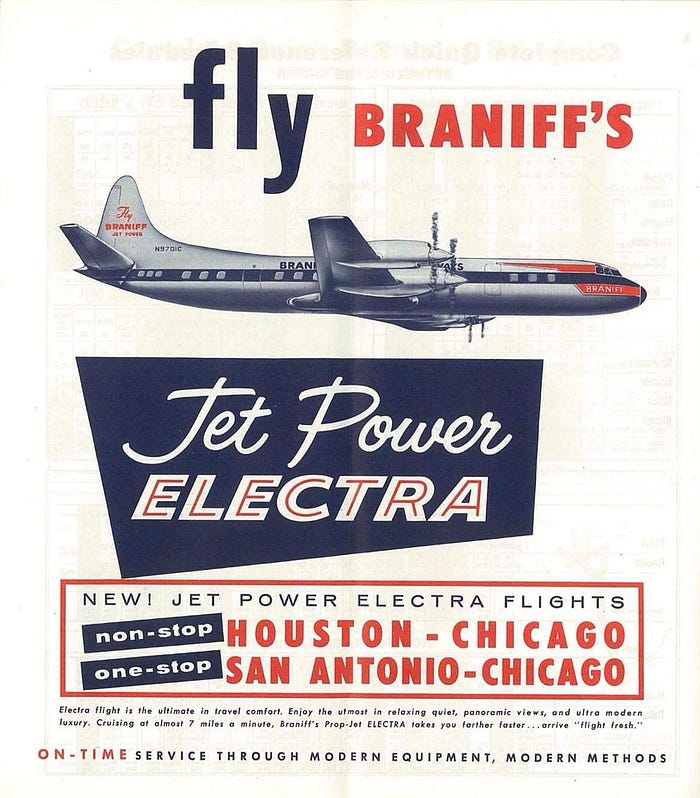
Until its demise in 1982, Braniff International Airways was one of the most prominent passenger airlines in the Great Plains region of the United States, connecting long chains of cities from Mexico and Texas northward. Already a long-established carrier, in the late 1960s Braniff was in the process of converting to an all-jet fleet featuring Boeing 727s, Douglas DC-8s, and British-built BAC 1–11s, in keeping with its image as a relatively upscale airline, but by 1968 it still had one mainline turboprop type in its fleet — the Lockheed L-188 Electra. Introduced only nine years earlier in 1959, the four-engine, propeller-driven Electra was already being superseded by increasingly advanced jets, and production of the type had ceased in 1961 following a series of deadly crashes. Although the design flaws that caused the accidents had long since been fixed, and no further accidents had occurred since 1962, the planes were on their way out by the end of the decade, and Braniff already had plans to retire its fleet of 11 Electras in 1969.
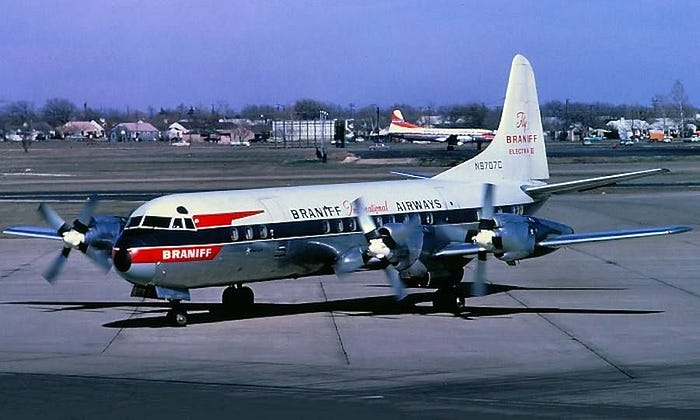
It was one of these Electras, N9707C, that arrived in Houston, Texas from Dallas on the afternoon of May 3, 1968. In command was 46-year-old Captain John Phillips, an experienced pilot with 10,900 flying hours in a variety of aircraft, including the Convair 340, the Boeing 727, and of course the Electra, which he had flown from 1964 to 1966 as a first officer, before returning as captain only one day before the fateful flight. He had actually completed training as an Electra captain in February 1967, but he remained a captain on the Boeing 727 roster for over a year after that, switching to the Electra only upon passing a currency check on May 2, 1968. Although he was extremely new to the role — it was hardly possible to be any newer — his flying skills were hardly in doubt, as the examiner who conducted his check described his knowledge as extensive and his landings as “beautiful.”
Joining him that day were two additional flight crew members, consisting of 32-year-old First Officer John Foster, who had been flying for Braniff since 1966 and had about 2,500 hours; and 28-year-old Flight Engineer (officially Second Officer) Donald Crossland, who joined Braniff in October 1967 and had about 750 hours as a flight engineer on the Electra. Also on board were two flight attendants, for a total of five crewmembers.

Having just completed an uneventful flight from Dallas, the plan was to turn around at Hobby Airport in Houston and fly straight back, reversing the journey between the two largest cities in Texas. The pilots were probably not expecting any notable obstacles — although perhaps they should have been. The last time either pilot had spoken to a dispatcher was prior to leaving Dallas at 12:40, when the First Officer was informed that there was no significant weather in the area, and indeed, the entire flight to Houston had been smooth sailing. Once in Houston, neither pilot visited the Weather Bureau office, nor did they speak to any dispatcher about the weather, choosing instead to check the paperwork provided to them by the company for any relevant weather information.
The extent to which they reviewed this material is not known, but if they did examine it, they would have learned that by the time they expected to approach Dallas between 16:40 and 17:00, the situation was forecast to have changed drastically. Powerful afternoon thunderstorms are commonplace on the Great Plains at that time of year, and the third of May 1968 was no exception. The Weather Bureau Aviation Area Forecast for the region warned of possible tornadoes in a region stretching from north central Texas into southeastern Oklahoma, including much of the Dallas metro area, and the Kansas City-based National Severe Storms Forecast Center was predicting hail up to two inches (5 cm) in diameter, extreme turbulence, and surface winds of up to 65 knots in severe thunderstorms. At the same time, Braniff’s own meteorological department warned of locally severe thunderstorms across a large area of central to northeastern Texas, including most of the second half of their planned route, with potentially extreme turbulence and hail up to 1.5 in (3.8 cm) inside the larger storm cells.
Despite these concerning forecasts, there was no indication that the storms would prevent the flight from reaching its destination, and so N9707C departed Houston Hobby Airport at 16:11, operating as Braniff flight 352, with 80 passengers and five crew aboard. The flight climbed uneventfully to its cruising altitude of 20,000 feet, then proceeded north-northwest toward Dallas Love Field along a defined route known as Jet Airway 87.
By 16:35, however, it had become apparent to the crew that their route forward would not be simple. Their on-board black-and-white weather radar was painting a nearly solid line of thunderstorms stretching from southwest to northeast across their path — a powerful formation known as a squall line, where intense storms form along the leading edge of an advancing cold front. These thunderstorms promised to conceal all manner of dangers, from massive hailstones to rapidly shifting winds or even tornadoes, but one way or another, they would need to find a way either around or through this formidable obstacle.

Observing the squall line on radar, Flight Engineer Crossland said, “What’s that, about sixty miles in front of us?”
“Yeah,” said Captain Phillips. “It’s a storm, and it looks like a pretty good one, too. Looks like we’d better deviate to the west.”
Hopping on his radio, First Officer Foster said, “Houston Center, Braniff three fifty two, a few miles up the road we’d like to deviate to the west, looks like there’s something in front of us.”
“Roger, one moment,” Houston Center replied.
“See if we can get fifteen thousand,” Captain Phillips suggested.
“And three fifty two would like to descend to fifteen thousand if we can get it please,” Foster added.
By this point, flight 352 was closer to Dallas than it was to Houston, however, so the controller replied, “Braniff three fifty two, contact Fort Worth Center on one three three point three, they have your request for deviation.”
“Okay, thank you,” said Foster. Selecting the frequency for Fort Worth, he then transmitted, “Fort Worth Center, Braniff three fifty two, requesting fifteen thousand and requesting deviation to the west.”
“Braniff three fifty two, Fort Worth,” the new controller replied, “suggest deviation east of course, all the aircraft are deviating that way at the present time, over.”
Indeed, the situation at that moment clearly favored a deviation to the east, not to the west. According to weather radar data, there was a continuous band of intense storms stretching to the west of the city of Waco, and another connected band stretching northeast from Waco across Jet Airway 87 and into the path of flight 352. This northeastern band was two and a half times thicker than the band to the west, but it was possible to make an end run around its eastern tip while staying well clear of any storms. There was no obvious gap to the west, but the squall line was thinner there, even though the maximum precipitation intensity depicted on radar was identical everywhere. In fact, the radar echoes were so bright, and the precipitation within them so intense, that air traffic control radar could not even see aircraft operating behind them.
Why exactly Captain Phillips wanted to deviate to the west is not known with any degree of certainty. It was clear to most everyone else that a deviation to the east would have been preferable, including, as the controller stated, every other flight crew in the area. Some possible reasons why Phillips chose to go against the grain will be discussed later, but it suffices to say that the decision was dubious from the start, and although none of the other flight crew members questioned it, the all-seeing eye of hindsight says perhaps they should have.
Despite the controller’s warning, however, the crew stuck steadfastly to their plan. “Three fifty two, [it does] look better on our scope here, it looks like to the uh, a little, just a little bit to the west would do us real fine,” First Officer Foster said.
The controller did not possess the authority to deny the deviation request as long as the airspace was free, so despite his skepticism he said, “Three fifty two, deviation west of course is approved, stand by on the altitude change and squawk ident, over.”
“It looks like there’s a hole up ahead to me,” Captain Phillips commented.
“Yeah,” Foster agreed.
At that moment the controller called them again and said, “Braniff three fifty two, radar contact, will have lower altitude shortly.”
“Okay, three fifty two,” Foster replied.
Picking up the public address system, Captain Phillips now said, “Okay ladies and gentlemen, this is Captain Phillips, we’re cruising at twenty thousand feet, our ground speed at this altitude is three hundred and fifty miles an hour… the weather in Dallas on the last sequence they were giving is three thousand scattered, ten thousand scattered, high broken, visibility is six miles with haze and smoke, temperature is eighty two degrees, wind is out of the southeast at eight. At the present speed we expect to arrive in Dallas on schedule, the schedule being, uh… four fifty-eight. Just ahead we have a little line of thundershowers, we’re going to deviate a little bit to the west… this might require two or three more minutes, but I think it will be much more smooth and comfortable. Been a pleasure having y’all on board today. I hope you have a very pleasant day in Dallas, those of you who are deplaning in Dallas. Since February the first, Braniff International has been the number one airline on time, we hope to maintain that record. In April we had almost ninety-six percent on time which is leading the industry still. Anytime you have any comments or suggestions that might in your opinion make this a better airline, let us know. Thank you very much for your patronage. Those of you who are continuing past Dallas, we’ll be departing Dallas for Tulsa at five twenty-five.”
Just as his lengthy passenger announcement was ending, the controller called with their new altitude. “Braniff three fifty two, descend and maintain one four thousand, over.”
“Three fifty two, we are at flight level two two zero for one four thousand,” said First Officer Foster.
At that moment, Captain Phillips picked up the intercom again, but the first part of his commentary was stepped on by a transmission between air traffic control and another aircraft. The cockpit voice recorder captured only the end: “…we’ll be able to go well under and to the west of all the thundershowers, but they will be visible to the right, and then since they have just moved from the west, it might still be just a little choppy there, so if you will sit down and remain seated until we turn off the seatbelt sign I’d appreciate it. Thank you.”
Flight 352 was now descending toward the squall line at a point west of their original course, the storms drawing nearer with every passing moment.
“Is it raining there?” First Officer Foster asked, presumably pointing somewhere outside. None of the other crewmembers replied.
“Braniff three fifty two, you’ve got company traffic at ten o’clock, eight miles, northeast-bound at one three thousand,” the controller suddenly said. “Waco altimeter is two niner seven six, and he’s deviating east of course.”
Below them, another Braniff flight coming in from a more westerly airway was crossing underneath them in order to deviate to the east around the storm. Clearly this other crew did not believe there was a “hole” anywhere nearby.
“Three fifty two, roger,” said Foster. “We don’t have him in sight yet. He’s deviating east of course.”
Moments later, the pilots did manage to spot the traffic as it crossed beneath them, headed parallel to the squall line for its end run around the storms. But Captain Phillips was unmoved, and continued straight ahead. “We’re ready to start descent,” he said. He evidently believed that he would be better off trying to cut below the squall line in order to stay out of the clouds.
“Fort Worth, Braniff fifty two, requesting lower altitude please,” said First Officer Foster.
“Braniff three fifty two, I’m unable right now, your company traffic is right under you,” said the controller. “Just as soon as you’re clear of him I’ll have something lower. What’s your heading now?”
“Braniff three fifty two, we’re turning over to a heading of three forty degrees [now],” said Foster.
“Braniff three fifty two, roger,” said the controller. A short time later, he came back and said, “Braniff three fifty two, descend and maintain five thousand, over.”
“Three fifty two, descending to five thousand,” said Foster.
The storm was looming dead ahead of them now, black and angry. “Oh hell,” Captain Phillips said, his comment punctuated by nervous laughter.
“Braniff three fifty two, do you indicate the area you’re going into there now as being, uh…” the controller started to say.
“We’ll have to stick to it,” Captain Phillips interrupted.
“…fairly clear, or do you see openings through it?” the controller concluded.
“Eh, three fifty two, it’s not clear, but we think we see an opening through it,” Foster replied, cryptically.
“Braniff three fifty two, roger,” said the controller.
“Hear that? Ask if there’s reports of hail,” Captain Phillips asked.
“Three fifty two, do you have any reports of hail in this area?” Foster said, relaying the request.
“No, you’re the closest one that’s ever come to it yet,” said the controller. “I haven’t been able to get anybody to — well, I haven’t tried really to get anybody to go through it, they’ve all deviated around to the east.”
Captain Phillips didn’t like where this was going. “Don’t talk to him too much,” he said to Foster. “I’m hearing his conversation on this. He’s trying to get us to admit that [we made] a big mistake coming through here.”
“It looks worse to me over there,” First Officer Foster agreed, referring to the area to the east.
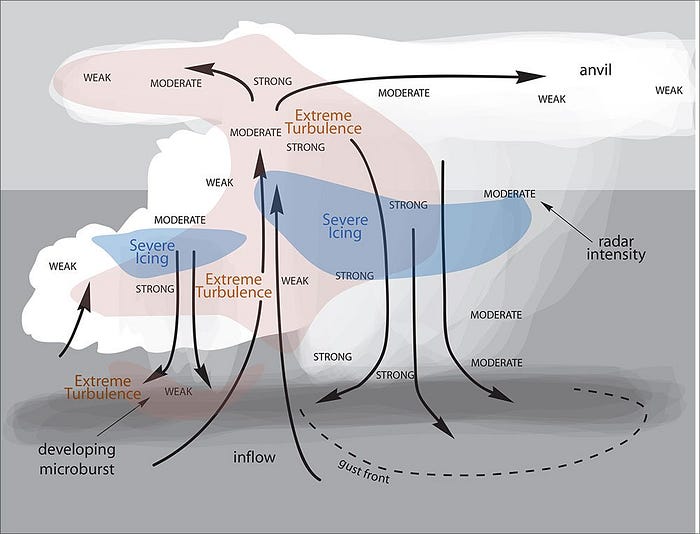
Unfortunately, they had indeed made a “big mistake,” a fact which was about to become all too apparent. On the ground below, residents of the small town of Dawson, some 50 kilometers northeast of Waco, could already see that the situation was fast deteriorating as the squall line bore down on their community. The dark wall of the storm was tinged with a deep, disturbing color that witnesses variously described as black, green, or purple, with a leading edge advancing before it, rolling and boiling across the landscape at the vanguard of a great mass of menacing moisture and crackling lightning. As the thunderstorm’s powerful outflow strafed the countryside, one local family driving on a nearby highway was hit with a sudden blast of wind so strong it forced them to stop their car, unable to continue. And yet, even as those on the ground hurried to shelter, flight 352 powered directly into the jaws of the leviathan, disappearing from view behind a tower of roiling gray.
On board the plane, the passengers and crew were immediately jolted by heavy turbulence, triggering an intermittent landing gear alarm as the rough air jostled the warning horn. “Let it ring,” Captain Phillips declared. The cockpit voice recorder captured the background roar of heavy rain.
Within seconds, however, the magnitude of his mistake became clear, and Captain Phillips finally balked. As turbulence continued to throw them in every direction, he said, “Let’s make a one-eighty.”
“One-eighty?” Foster asked.
“Yeah,” said Phillips.
In fact, Captain Phillips had already begun to turn before he first expressed a desire to reverse course. Now level at 10,000 feet, flight 352 had been turning right at a bank angle of about 24 degrees for the last ten or fifteen seconds, but they were still headed deeper into the storm, and more drastic action was needed.
“Braniff three fifty two would like to make a one-eighty please,” Foster said to air traffic control.
“Braniff three fifty two, one-eighty right or left is approved,” the controller replied.
“Three fifty two,” Foster acknowledged. This would be the last anyone ever heard from the ill-fated Electra.
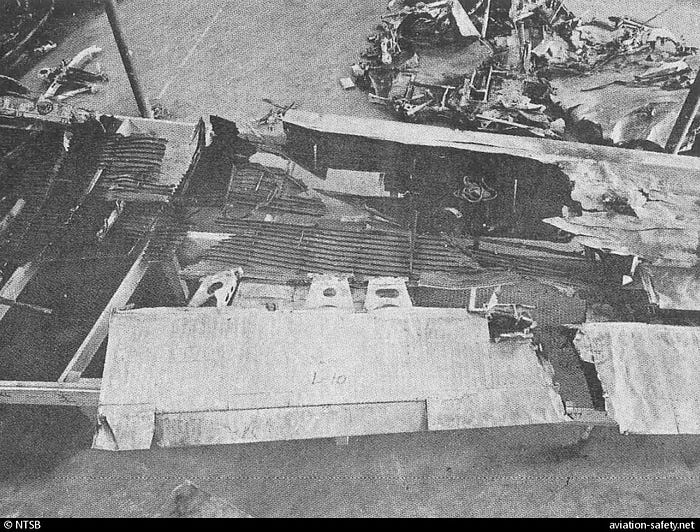
As Captain Phillips began banking steeply to the right, he said, “Let me know when we come back around there to reverse heading for rollout.” But at that very moment, a powerful gust slammed into the plane, throwing it hard into the roll; the bank angle rapidly increased, passing through 66 degrees, then 90. With the plane completely on its side, the wings lost lift and the nose fell through, pitching down into a terrifying spiral descent. The bank angle briefly peaked at 115 degrees as flight 352 plunged inverted from the sky, pitched 37 degrees nose down and accelerating alarmingly. Captain Phillips attempted to roll wings level, snapping back to 52 degrees right, but they were still spiraling inward, accelerating through 360 knots and approaching the ultimate limits of the airframe. Phillips pulled back on the nose as he rolled left, trying desperately to get them out of the spiral; the pullout subjected the aircraft to 3 G’s of load, then four, pinning the passengers and crew alike hard into their seats as a cacophony of spurious alarms blared in the cockpit. The wings bent upward under the mounting G-forces, straining to bring the plane out of its death spiral, but it was too late. As the vertical acceleration surpassed 4.3 G, the cockpit voice recorder captured a series of horrifying creaks and groans, and then the right wing failed catastrophically, tearing away in the blink of an eye. The horizontal stabilizers and tailfin followed a split second later, ripping open the aft fuselage; fuel liberated from the tanks ignited into a sudden fireball. Lightning ripped through a darkened sky as the burning hulk of the Electra plunged through the base of the storm and into open air, streaking down in a long, descending arc, smoke billowing behind it. Seconds later, with a muffled boom, what was left of flight 352 slammed into a field outside Dawson, taking with it the lives of all 85 passengers and crew.
◊◊◊

When emergency services reached the crash site minutes later, they came across a scene of desolation. Pieces of the Electra lay strewn over an area 5 kilometers long and 600 meters wide, beginning from a pair of craters in a field where the main portion of the plane came down at a high rate of speed. The fragmented bodies of the victims were found here, but other debris had continued downwind for a considerable distance, including the shattered remnants of the right wing, the stabilizers, flight controls, and pieces of the empennage. It was swiftly clear not only that no one had survived, but that the impact was so violent as to preclude even the recovery of complete remains. The only body found in one piece was carried in a coffin in the cargo hold, surviving intact by virtue of being already deceased and ensconced in a box.
The cleanup process would ultimately drag on for days, affecting a generation of Dawson residents who were thrust into an unfamiliar role as custodians of the dead and comforters of the bereaved — but that is a story to be told at another place and time.
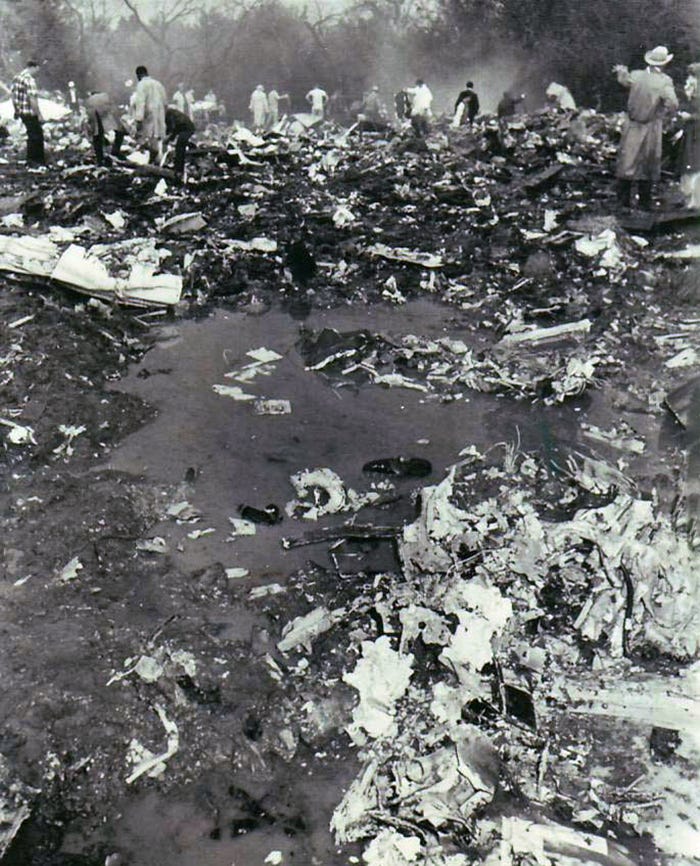
As the recovery process got underway, investigators from the newly created National Transportation Safety Board arrived at the grisly scene to begin their own inquiry into the cause of what was then the deadliest air crash in Texas history.
The wreckage itself revealed right away that the plane had broken apart violently in the air before tumbling uncontrolled to the ground below — not only because parts were scattered over such a wide area, but also because the main fuselage section, with the left wing still attached, had apparently impacted the ground traveling backwards. At the crash site, the first of two craters was gouged out by the impact of the cockpit, followed by a second crater associated with the fuselage section, while a tree was found embedded into the trailing edge of the left wing; taken together, these clues painted a picture of the plane’s terrifying final moments, plummeting backward with its nose down and its left wing up. But how had this happened? What mighty force had torn the plane apart so violently?

A few obvious possibilities were ruled out swiftly. Although witnesses saw lightning strike near the plane at almost the same moment that they saw the fireball, no evidence of a lightning strike on any of the aircraft debris was found, nor was there any evidence of an explosion having occurred before the right wing broke off. Sabotage was ruled out for these same reasons.
In fact, the answer came only after a detailed mathematical analysis of the plane’s final moments, based primarily on data from its primitive flight data recorder, which inscribed traces corresponding to heading, airspeed, altitude, vertical acceleration, and time into a spool of rotating foil. These data revealed that as soon as the plane entered the storm, the vertical acceleration trace began recording deviations ranging between 0.2 and 1.6 G, indicating heavy turbulence. Shortly thereafter, at about 16:47 and 10 seconds, the heading trace indicated that a right turn was initiated, which suddenly increased dramatically at 16:47:21, shortly after Captain Phillips expressed his desire to pull a one-eighty. At the same time, large excursions in vertical acceleration were recorded, followed by an extremely rapid loss of altitude peaking at 16,200 feet per minute. The airspeed increased from 216 knots to 360 knots in only eight seconds, and then shortly before the end of the recording, both the heading and airspeed traces actually reversed direction, appearing to move against the flow of time, indicating that the foil spool and the recording styli were subjected to extreme forces. The last recorded vertical acceleration was 4.3 G, at which point the aircraft broke apart and the recording ceased at an altitude of 4,500 feet.

These data indicated that a loss of control occurred, while the decreasing airspeed and increasing vertical acceleration in the final seconds strongly suggested that the pilot was attempting to recover, only to overstress the airframe while pulling out of the spiral dive. This raised two major questions: first, why did this loss of control occur; and second, did the strength of the airframe meet certification requirements?
Regarding the second question, an exhaustive examination of every portion of the failed right wing and stabilizers turned up no evidence of pre-existing damage or metal fatigue, except for a small area of minor corrosion located outside the area where the right wing began to split apart. Alternatively, two Electras had broken up in mid-air in 1959 and 1960 due to unstable propeller mountings, resulting in catastrophic flutter of the wing, but this issue had been exhaustively studied and corrected in 1961 and should have been fixed, so it was no great surprise when no evidence of wobbling propellers or flutter was found. Instead, all available evidence indicated that the right wing was in good condition, but had been subjected to overstress with components of upward bending and rearward torsion, which increased in magnitude until it simply ripped off. This was completely consistent with the wing having separated while the pilot was pulling up and banking left in an attempt to escape a high-speed spiral dive.
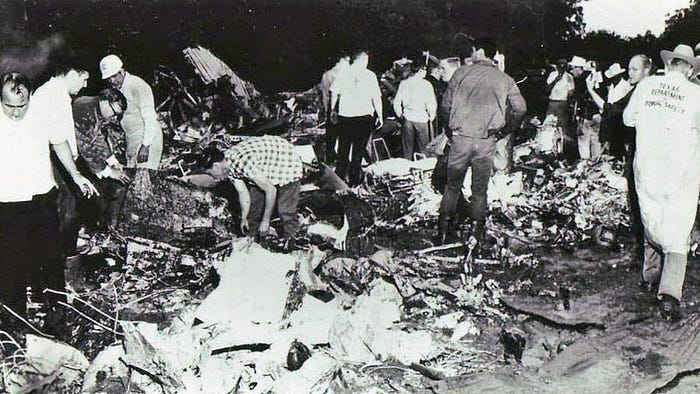
As for how the loss of control occurred, and how the NTSB figured it out, it helps to know a little bit about the concept of “load factor.”
Load factor is a unitless value equal to an aircraft’s lift divided by its weight. When in straight and level flight, lift and weight are equal, so the load factor is 1. This is often referred to as “1 G flight,” with G referring to the force of gravity. This unit is often applied to load factor as well in order to approximate the forces that the occupants of an aircraft will feel during a maneuver, which is what is meant when we say an aircraft pulled a certain number of G’s. The force of the earth’s gravity (G) doesn’t actually change; it is always equal to 1, but this can then be multiplied by the load factor to arrive at the “G-force” equivalent felt by the occupants.
During a banked turn, load factor increases at a rate roughly equal to one over the cosine of the bank angle (1/cosθ), so that at a bank of 60 degrees, the expected load factor is 2. Furthermore, a higher load factor increases the speed at which the plane will lose lift and stall. Therefore, as bank angle increases, load factor increases, which increases the stall speed, until at some particular bank angle the stall speed catches up to the plane’s actual speed and a stall occurs. Lift will then decrease rapidly, which also causes load factor to decrease, because lift is the numerator in the load factor ratio (n = L/W). This should make intuitive sense, because in level flight the wings produce lift that pushes up against the downward pull of gravity; therefore, if the plane is sideways, the wings cannot push up against gravity, and the plane should fall — so the above is simply a more accurate way of explaining this intuitively obvious phenomenon.
This fundamental relationship between bank angle and load factor allowed the NTSB to derive a parameter that was not tracked by the flight data recorder: the aircraft’s bank angle. Furthermore, by cross-referencing with heading before that parameter became invalid, it was possible to “see” turbulence in the data, wherever the vertical acceleration parameter (which is really the same thing as load factor) ceased to match with the expected bank angle that would produce the recorded rate of heading change. This analysis revealed that as flight 352 began its right turn, it was probably banked about 24 degrees right with an expected resultant load factor 1.1, which is approximately what was recorded. Subsequently, the rate of heading change increased after 10–15 seconds, consistent with a rapid increase in bank to 66˚ between 16:47:20 and 16:47:25. This would be expected to produce a load factor of 2.5, but the recorded vertical acceleration actually varied wildly between 0.1 and 2.8, for an average of 1.0. This large discrepancy could only mean that a powerful gust of wind was affecting the plane during that period. A gust strong enough to reduce the vertical acceleration by an average of -1.5 G could easily have caused Captain Phillips to lose control of the plane if it occurred at the same time as he initiated the steep 180-degree turnback.
Within five seconds after the gust peaked, the vertical acceleration and heading values suggested that the airplane may have briefly reached a bank angle of 115 degrees before beginning to correct. For the reasons explained earlier, this high bank angle resulted in a loss of lift that swiftly translated into a rapid nose-down descent, which was indicated by a sudden decrease in both vertical acceleration and altitude. The last bank angle that could be derived was 52 degrees right, indicating an attempted recovery, before the heading trace appeared to reverse against the flow of time, making further calculations impossible. However, by that point the load factor was increasing rapidly not due to bank angle, but due to the pilots’ attempt to pull up, as the wings strained to bring the plane out of its descent while the aircraft’s center of gravity kept trying to hurtle downward under its own momentum. The failure of the right wing at a load factor of 4.3 was somewhat lower than the expected failure threshold of 4.77 derived in certification testing by Lockheed, but simulations showed that the localized load factor on the wing could have reached this value due to wing torsion from the pilot’s attempt to bank, in combination with asymmetric gust loading associated with the turbulent air inside the thunderstorm, neither of which would have been recorded by the FDR, which measured vertical acceleration at the center of gravity.
◊◊◊
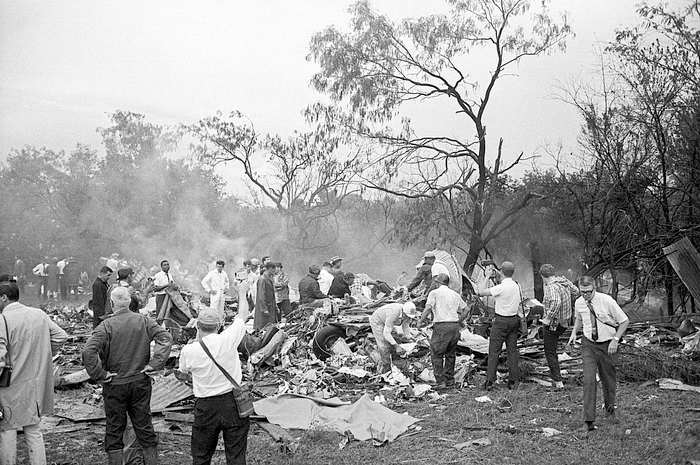
As impressive as all these technical details were — don’t worry if you struggled to follow — they told only part of the story. They explained what happened, but not why, and as the NTSB was forced to note, most of the “why” lay in the decision-making of the flight crew.
The testimony of witnesses agreed that the plane flew into a violent storm featuring boiling black clouds, lightning, and frightening winds. This flew in the face of good aeronautical practice, which has long held (correctly) that flying into thunderstorms is dangerous and should not be attempted. Braniff’s flight manuals in fact stated that thunderstorms must be circumnavigated by at least five miles, which was consistent both with the best practices of the time and official advice today. And yet, for some reason, the crew of flight 352 entered the storm anyway.
Based on their statements on the cockpit voice recording, the pilots initially seem to have believed that there was a hole between storm cells west of their course, even though nobody else that day appeared to be aware of such a gap. Given that they evidently did not find a hole, nor was there any evidence that one had ever existed, the NTSB turned to a subtle clue to explain their decision: the tilt of their airborne weather radar. Radar “tilt” is more or less what it sounds like — that is, the angle of the radar transmitter relative to level. Pilots can adjust the tilt up and down in order to reveal the intensity of precipitation at altitudes above and below their present flight level, enabling more informed decision-making when flying near storms. But an analysis of the wreckage of the radar transmitter showed that the tilt was set to 8 degrees up at impact, and the pilots never discussed adjusting it. If the tilt was in fact set to 8 degrees up throughout the flight, as this evidence implied, then the radar display might have shown what appeared to be gaps between storm cells, but which were actually just low spots in between cloud towers that reached as high as 45,000 feet. If they flew into one of these “gaps” at only 10,000 feet, they might have quickly discovered that at that altitude, the storm was continuous.
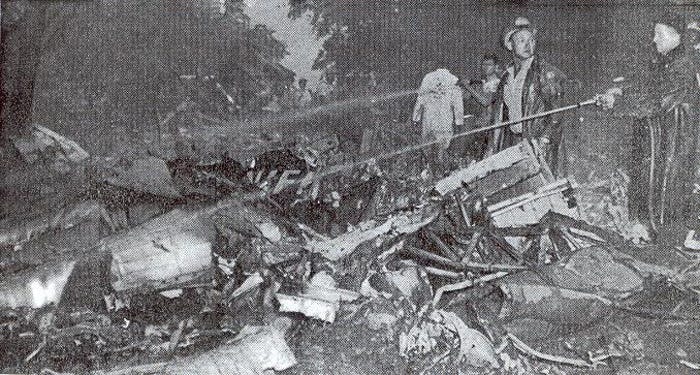
Once inside the storm, however, they were committed. In fact, Captain Phillips’ decision to turn around almost definitely sealed their fate. As an experienced captain with a full set of functional instruments and a flawless training record, Phillips surely would have been able to execute such a turnback in clear weather, but inside the thunderstorm, the unpredictable, shifting winds caused him to lose control. This is why official advice, both then and today, is to avoid maneuvering inside a thunderstorm, should one find oneself in such a situation. The turbulent wind conditions within a thunderstorm can significantly reduce an aircraft’s margins of controllability in all axes, so the best course of action is to continue straight ahead at the prescribed turbulence penetration airspeed and hope you make it out the other side in one piece. Although the realization that he had brought his unwitting passengers into a monstrous storm clearly triggered an instinctive desire to escape back the way he came, Phillips’ decision to make a steep turn in those conditions was profoundly unwise.
◊◊◊

One excellent way to look at the events leading up to the crash is through the lens of the Federal Aviation Administration’s so-called “five hazardous attitudes,” consisting of anti-authority, impulsivity, invulnerability, macho, and resignation. The FAA graphic above provides more detailed definitions of these attitudes.
Because none of us was inside Captain Phillips’ head, we can’t say exactly what he was thinking, but some of his actions are similar to those associated with the hazardous attitudes. For instance, the official report does not speculate about why the pilots preferred to chase a phantom gap over the option to circumnavigate the squall line, but given Captain Phillips’ comments about punctuality during his passenger announcement, it’s possible that he simply thought the westerly route would save time. The air traffic controller did his best to dissuade him, but he refused to change his mind, and in fact his statement just before they entered the storm — “Don’t talk to him too much… He’s trying to get us to admit that [we made] a big mistake coming through here” — raises the possibility that his decision to continue was partly informed by an anti-authority attitude, a desire not to let the controller feel like he had “won” the exchange. This could have contributed to Phillips’ otherwise inexplicable decision to continue even after it should have become clear that there was no gap.
Furthermore, it’s also worth noting that this was Captain Phillips’ first full day as a Lockheed Electra captain. His new position also might have been considered a downgrade from his previous post as captain on the jet-powered Boeing 727, potentially leaving him with something to prove. That’s not to say that he was purposefully reckless, but rather that anyone in such a position might feel pressure to demonstrate that they’re capable of independent decision-making and leadership, which can lead to the “I can do it” mindset associated with the “macho” hazardous attitude, shown in the above graphic.
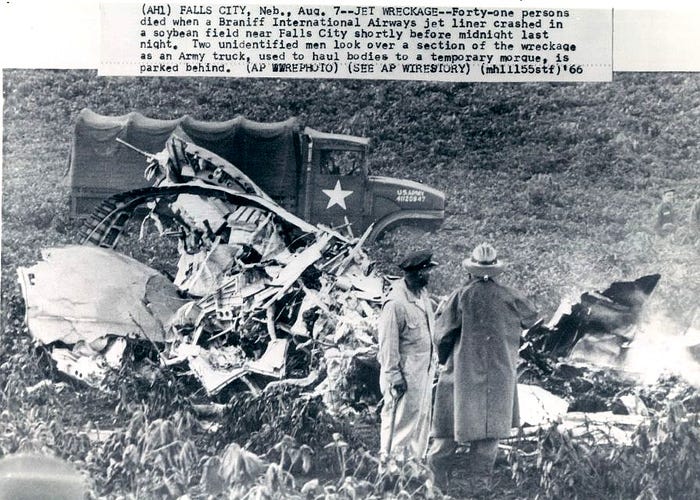
Lastly, given the context in which flight 352 was operating, there may have been an element of invulnerability as well.
In fact, less than two years earlier, on August 6, 1966, another Braniff International Airways flight had suffered much the same fate, with equally deadly consequences, under very similar circumstances. This previous accident involved Braniff flight 250, a BAC 1–11 twin rear-engine jet operating a scheduled leg between Kansas City, Missouri, and Omaha, Nebraska, on a stormy summer night. Prior to departure from Kansas City, the crew learned of severe thunderstorms from their weather briefing materials and from a company captain on a recently arrived flight, who told them that a line of storms north of the airport was one of the worst he had ever seen. Indeed, their radar was painting a severe squall line, much like the one later encountered by flight 352, but the dispatcher at Kansas City had received inaccurate weather information and urged them to depart. The captain accepted this, and just before 23:00, flight 250 took off directly toward the squall line.
As the flight proceeded northbound at 5,000 feet, the first officer suggested that they deviate around the squall line, but the captain, having picked up what he thought was a hole in the storm system, insisted that they penetrate it instead. Then, as the plane approached the squall line, they passed unknowingly over the top of a fast-moving roll cloud associated with the advancing cold front, at which point they encountered extreme turbulence. Before the pilots could attempt to escape, an awesome wind gust, stronger than any previously measured, slammed the plane up and to the left with such ferocity that it entirely tore off the right horizontal stabilizer. The NTSB would later calculate that the gust reached a net velocity of at least 83 knots — equivalent to the sustained winds inside a category 2 hurricane — with a buildup time of only one eighth of a second, dealing such a massive blow as to have destroyed any commercial airliner then in service. Subsequently, minus its pitch control surfaces, the plane pitched down so sharply that the right wing failed in overstress, and the rest of the aircraft then tumbled into a flat spin, plunging like a leaf from 5,000 feet. Flight 250 crashed some 24 seconds later in a field near Falls City, Nebraska, killing all 42 passengers and crew.

The fact that another Braniff crew had lost their lives less than two years earlier after merely flying too close to a severe squall line, let alone into one — flight 250 in fact broke apart while still 5 nautical miles from the nearest precipitation visible on radar — should have imbued the crew of flight 352 with a healthy fear for their own safety. And yet, despite presumably being aware of what befell their colleagues, they decided to fly directly toward and then into a squall line without expressing the slightest hint of alarm. The inability or unwillingness to recognize that they were placing themselves in the same situation as the crew of flight 250 is consistent with the FAA’s definition of invulnerability — the sense that accidents only happen to other people.
Nevertheless, I would like to conclude by reminding my readers that these attitudes can influence anyone, and it’s much more important to recognize them in ourselves than it is to try to find them in others. I can only hope that the above discussion provides concrete examples that will be useful for this purpose.
◊◊◊
In the end, the NTSB noted that this was a type of accident that the industry already knew how to prevent. And yet, despite airline policies and training aimed toward avoiding thunderstorm penetration, accidents like Braniff flight 352 continued to occur. Consequently, the NTSB and the FAA launched what essentially amounted to an awareness campaign urging flight crews to avoid severe thunderstorms by a wide margin rather than trying to fly between them, among other activities intended to keep planes and storms farther apart.
As part of this campaign, the FAA issued an advisory circular in June 1968 detailing known information about thunderstorms and how to fly near them — or rather how not to, reminding pilots that any thunderstorm could contain extreme weather phenomena. However, the weight of the FAA’s language progressively increased in subsequent revisions of the document in 1978, 1983, and 2013, creating an interesting chronology of expert thinking with regard to the thunderstorm penetration problem. By 1983, for instance, the advisory circular explicitly warned that attempting to maneuver inside a thunderstorm “produces greatly increased stress on the aircraft,” and that, “to date, we have no sure way to pick ‘soft spots’ in a thunderstorm.” However, it still said that any thunderstorm “should be considered hazardous until measurements have shown it to be safe,” implying that there is such a thing as a safe thunderstorm, which there is not; and that “almost any thunderstorm can spell disaster for the wrong combination of aircraft and pilot,” implying that there is a right aircraft and pilot for penetrating a thunderstorm (in which case, obviously, the right aircraft is “my aircraft” and the right pilot is “me”). By 2013, however, these ambiguities had disappeared, and the advisory circular now states, “Weather recognizable as a thunderstorm should be considered hazardous, as penetration of any thunderstorm can lead to an aircraft accident and fatalities to those on board.” Truly, there’s nothing quite as effective as telling it like it is!
Other modern FAA publications also don’t mince words. One safety document says, “Although pilots have flown through limited state thunderstorms with little or no damage to the aircraft or passengers, these pilots should consider themselves extremely fortunate to be alive.” Furthermore, it adds, “If the aircraft inadvertently penetrates the thunderstorm, maintain a straight and level altitude on a heading that will take you through the storm area in the minimum time.” And just to conclude, the document notes, “Never let compulsion take the place of good judgment.”
◊◊◊
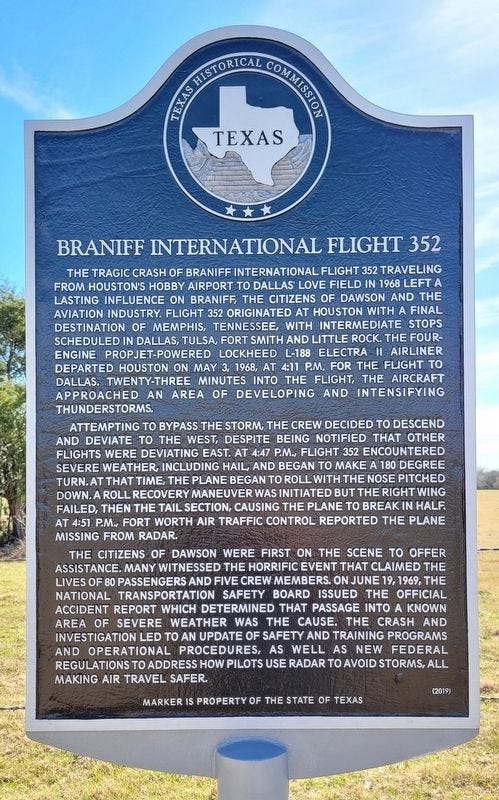
These principles should be well-known to pilots today, and all air crews should know that extreme thunderstorms like those found on the Great Plains of the United States can cause a loss of control or in-flight breakup. Anytime severe weather pops up in that region, this fact can be verified on flight tracking apps, where long streams of planes can be seen circumnavigating large storm cells at a safe distance, like a river forking around a boulder. Although smaller, less intense thunderstorms are still occasionally penetrated, today it would be nigh unimaginable for an airline pilot faced with an obviously severe storm to break from that stream and, like flight 352, plunge heedlessly into the tempest. However, this culture of avoidance became properly entrenched only through tragedies like this one — disasters which demonstrated that coexistence with the forces of nature is possible but for the hubris of man. We are all safer for admitting that the thunderstorm is a fatally beautiful machine, a natural masterwork alluring in its grandeur, yet one best viewed from a safe distance.
_______________________________________________________________
Join the discussion of this article on Reddit
Support me on Patreon (Note: I do not earn money from views on Medium!)
Visit r/admiralcloudberg to read and discuss over 250 similar articles
